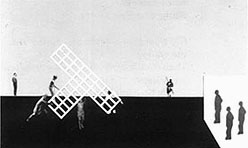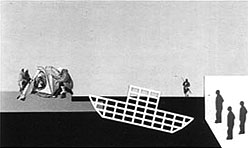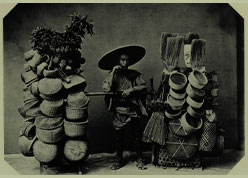

below Knee Play 10
Presentation collages by Adelle Lutz
THE CIVIL WARS: THE AMERICAN SECTION
the Knee Plays is a series of brief encounters which, as a group, tells a tale of a tree, a boat and a book. The three to six minute plays are designed to be set between the fifteen fully staged scenes of Robert Wilson’s epic opera, the CIVIL warS: a tree is best measured when it is down.
the CIVIL warS is a multinational production created in sections in six countries, employing a dozen languages and hundreds of actors, singers and theatrical technicians. While formally structured, the images of the scenes and acts freely associate great characters of the past century and illustrate the spectacle of history.
Conceived for an international community, the CIVIL warS was originally designed as the keystone production in the 1984 Olympic Arts Festival for the XXIII Sports Olympiad in Los Angeles. Regrettably, the climactic collation of the six parts will not be shown there, but the concept and essence of the work remain unchanged.
The first of the sections to be produced was premiered at the Schouwbourg Rotterdam in Rotterdam on September 6, 1983 and the second at the Schauspiel Köln in Cologne on January 19, 1984. The third was produced in Rome by the Rome Opera and premiered on March 26, 1984. The American production is the Knee Plays produced by Walker Art Center in association with the Guthrie Theater for premiere on April 26, 1984. Two more sections have been produced in Japan and France. With sets built and costumes made, they have been rehearsed and now await performance.
For a presentation of the complete opera, each knee play would be performed as an entr’acte downstage in front of a white scrim during the massive scene changes. Knee plays are divertissements, or “joints,” between the scenes. They provide a continuity of action much as olios offer entertainments between the acts of a burlesque or vaudeville show. the Knee Plays, however, form an independent and episodic cycle with a theme related to the broad sweep of apocalyptic visions played out on the main stage. They serve to continue the aura of dream-like revelations which emerge and evanesce in successions of scenes and tableaux.
Wilson’s operas suspend conventions of theatrical time. Five or six or a dozen hours are consumed, without intermission, as image after image is unveiled and moments flow into minutes and on into hours.
The Life and Times of Joseph Stalin (1973) was Wilson’s massive compilation of scenes from previous work restructured with new material that ran for twelve hours. Throughout the night the audience was free to come and go, to stretch, doze or get snacks at the theater’s concession stands.
